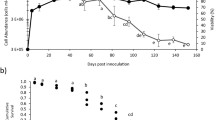Abstract
Chlamydomonas reinhardtii cells can double their size several times during the light period before they enter the division phase. To explain the role of the commitment point (defined as the moment in the cell cycle after which cells can complete the cell cycle independently of light) and the moment of initiation of cell division we investigated whether the timing of commitment to cell division and cell division itself are dependent upon cell size or if they are under control of a timer mechanism that measures a period of constant duration. The time point at which cells attain commitment to cell division was dependent on the growth rate and coincided with the moment at which cells have approximately doubled in size. The timing of cell division was temperature-dependent and took place after a period of constant duration from the onset of the light period, irrespective of the light intensity and timing of the commitment point. We concluded that at the commitment point all the prerequisites are checked, which is required for progression through the cell cycle; the commitment point is not the moment at which cell division is initiated but it functions as a checkpoint, which ensures that cells have passed the minimum cell size required for the cell division.
Similar content being viewed by others
Abbreviations
- DC:
-
daughter cell(s)
- MC:
-
mother cell(s)
References
Bišová K., Krylov D.M., Umen J.G.: Genome-wide annotation and expression profiling of cell cycle regulatory genes inChlamydomonas reinhardtii.Plant Physiol. 137, 475–491 (2005).
Coleman A.W.: The nuclear cell cycle inChlamydomonas (Chlorophyceae).J.Phycol. 18, 192–195 (1982).
Craigie R.A., Cavalier-Smith T.: Cell volume and control of theChlamydomonas cell cycle.J.Cell Sci. 54, 173–191 (1982).
Donnan L., John P.C.L.: Cell cycle control by timer and sizer inChlamydomonas.Nature 304, 630–633 (1983).
Donnan L., Carvill E.P., Gilliland T.J., John P.C.L.: The cell cycles ofChlamydomonas andChlorella.New Phytol. 99, 1–40 (1985).
Gorman D.S., Levine R.P.: Cytochromef and plastocyanin: their sequence in the photosynthetic electron transport chain ofChlamydomonas reinhardtii.Proc.Nat.Acad.Sci.USA 54, 1665–1669 (1965).
Goto K., Johnson C.H.: Is the cell division cycle gated by a circadian clock? The case ofChlamydonas reinhardtii.J.Cell Biol. 129, 1061–1069 (1995).
Harper J.D.I., John P.C.L.: Coordination of division events in theChlamydomonas cell cycle.Protoplasma 131, 118–130 (1986).
John P.C.L.: Control points in theChlamydomonas cell cycle, pp. 9–16 in W. Wiessner, D.G. Robinson, R.C. Starr (Eds):Algal Development, Molecular and Cellular Aspects. Springer-Verlag, Berlin 1987.
John P.C.L., Sek F.J., Lee M.G.: A homolog of the cell cycle control protein p34cdc2 participates in the division cycle ofChlamydomonas, and a similar protein is detectable in higher plants and remote taxa.Plant Cell 1, 1185–1193 (1989).
Lien T., Knutsen G.: Synchronous growth ofChlamydomonas reinhardtii (Chlorophyceae): a review of optimal conditions.J.Phycol. 15, 191–2000 (1979).
Matsumura M., Yagi T., Yasuda K.: Role of timer and sizer in regulation ofChlamydomonas cell cycle.Biochem.Biophys.Res.Commun. 306, 1042–1049 (2003).
McAteer M., Donnan L., John P.C.L.: The timing of division inChlamydomonas.New Phytol. 99, 41–56 (1985).
Münzner P., Voigt J.: Blue light regulation of cell division inChlamydomonas reinhardtii.Plant Physiol. 99, 1370–1375 (1992).
Oldenhof H., Zachleder V., van den Ende H.: Blue light delays commitment to cell division inChlamydomonas reinhardtii.Plant Biol. 6, 689–695 (2004).
Oldenhof H., Zachleder V., van den Ende H.: Blue and red light regulation of the cell cycle inChlamydomonas reinhardtii (Chlorophyta).Eur.J.Phycol. 41, 313–320 (2006).
Schlösser U.: Enzymatisch gesteuerte Freizetsung von Zoosporen beiChlamydomonas reinhardii Dangeard in Synchronkultur.Arch.Mikrobiol. 54, 128–133 (1966).
Spudich J.L., Sager R.: Regulation of theChlamydomonas cell cycle by light and dark.J.Cell Biol. 85, 136–145 (1980).
Sueoka N.: Mitotic replication of deoxyribonucleic acid inChlamydomonas reinhardtii.Proc.Nat.Acad.Sci.USA 46, 83–91 (1960).
Umen J.G., Goodenough U.: Control of cell division by a retinoblastoma protein homolog inChlamydomonas.Gen.Dev. 15, 1652–1661 (2001).
Vítová M., Zachleder V.: Points of commitment to reproductive events as a tool for analysis of the cell cycle in synchronous cultures of algae.Folia Microbiol. 50, 141–149 (2005).
Voigt J., Münzner P.: TheChlamydomonas cell cycle is regulated by a light/dark-responsive cell-cycle switch.Planta 172, 463–472 (1987).
Zachleder V., van den Ende H.: Cell cycle events in the green algaChlamydomonas eugametos and their control by environmental factors.J.Cell Sci. 102, 469–474 (1992).
Zachleder V., Jakobs M., van den Ende H.: Relationship between gametic differentiation and the cell cycle in the green algaChlamydomonas eugametos.J.Gen.Microbiol. 137, 1333–1339 (1991).
Zachleder V., Schläfli O., Boschetti A.: Growth-controlled oscillation in activity of histone H1 kinase during the cell cycle ofChlamydomonas reinhardtii (Chlorophyta).J.Physcol. 33, 673–681 (1997).
Author information
Authors and Affiliations
Corresponding author
Additional information
This study was supported by theSpace Research Organization Netherlands, which is subsidized by theNetherlands Organization for Scientific Research.
Rights and permissions
About this article
Cite this article
Oldenhof, H., Zachleder, V. & van den Ende, H. The cell cycle ofChlamydomonas reinhardtii: the role of the commitment point. Folia Microbiol 52, 53–60 (2007). https://doi.org/10.1007/BF02932138
Received:
Revised:
Issue Date:
DOI: https://doi.org/10.1007/BF02932138




